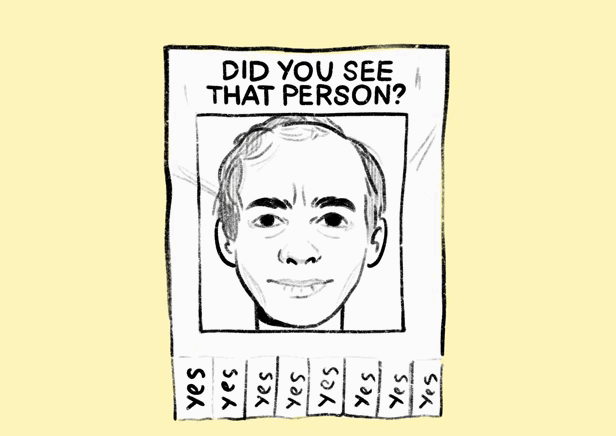How to recognize that you're being brainwashed: a psychological investigation
In the conditions of this problem, there are no resurrected dead or mischievous ghosts. However, in this scenario, there is a deserted island where ten people, who are completely unfamiliar with each other, have simultaneously found themselves. These people have no ties to one another. They all live on different continents, lead ordinary lives, and each has their own diverse hobbies and attitudes toward unexplained phenomena.
It would seem that since these people have nothing in common, they cannot be grouped together by any identifiable characteristic. Yet, there is one circumstance that unites them.
The fact is that each of these ten people claims to have encountered at least once in their life a mysterious figure — “Mr. X” — a middle-aged man with short graying hair, light stubble on his face, thick eyebrows, an indistinct smile, and heavy eyelids. He became known as “Mr. HIM.”
The legend goes like this: January 2006, New York, a psychiatric clinic. A woman draws a portrait of a man she constantly sees in her dreams. The drawing is left on the psychiatrist’s desk. A few days later, another patient sees the sketch and says, “Oh, I know him, he appears in my dreams too.” A third patient confirms the same. The psychiatrist sends the drawing to colleagues, and patients in other clinics claim they also see this character in their dreams.
The people stranded on the island each claimed in turn that they had seen this man — some in line at the grocery store, some passing him on a busy street in their city, some giving him their seat on public transportation, and others even seeing him in their dreams. It was as if the strange stranger had somehow managed to be everywhere at once. Yet, none of the ten people knew “Mr. X” personally, nor did they know each other. How is this possible?
In the winter of 2008, the mysterious stranger appeared in the dream of a marketer named Andrea Natella, asking Natella to create a website about him. The marketer was surprised but sketched the character and created the website, which started receiving letters from all over the world! By the way, the website still exists today. It turned out that the mysterious man was seen not only by people with mental disorders; everyone saw him.
There are two most likely solutions to this problem, and each may have its own validity. If one of the solutions provokes only curiosity and various reflections on the subconscious, the second may cause fear and even anxiety, as it has more serious implications. Just in case, we published both possible solutions, but which one comes closer to solving this mysterious problem is up to you to decide.
It’s no secret that throughout our lives, we are influenced by the collective unconscious — a certain form of our subconscious, whose rules are based on various pieces of information ingrained in us from birth. For example, some people have a phobia of snakes, even though they have never encountered one in their life. Others are terrified of driving, even though they have never sat behind the wheel of a car. A well-groomed and attractive person almost always makes a good and respectable impression on the subconscious, even though the subconscious has no idea what this person’s views on life are.
This is the work of the collective unconscious, our psychological heritage, with which each of us is born. The collective unconscious can manifest in a variety of life situations, and the mysterious “Mr. X” from the problem scenario helps us understand these manifestations.
The collective unconscious can be influenced by common cultural templates that shape our understanding of what certain types of people should look like. For example, in movies, villains always wear black hats and have moustaches, while heroes who save the world single-handedly always have white teeth and perfect hair. So, if someone sees a person in a black hat who resembles a favourite movie villain, they might immediately think that this person is evil. However, in reality, the man with the black hat might just enjoy wearing hats and has no sinister plans at all.
The collective unconscious can also be influenced by group dynamics. For instance, in a lively crowd where emotions are running high, someone loudly claims to have just seen Johnny Depp and even points to a man standing with his back turned. Few people can resist the temptation to approach the man for a photo, and few will stop to question what Johnny Depp might be doing in the most obscure bar in New Hampshire.
Memory and perception also influence the collective unconscious.
Memory is a process similar to an old video tape, where things are constantly erased or added. Memory generously fills in the gaps with details or fantasies, like blank pages in a diary. Knowing this feature of memory, it’s not surprising that several people could “remember” the same encounter with the mysterious “Mr. HIM.”
The collective unconscious is also influenced by the witness effect.
This effect occurs when several witnesses to the same event begin to recount it, and each adds their own twist. The result is a story that would make even Sherlock Holmes pause and ask, “Wait, how is all this connected?”
Jung’s concept of synchronicity also plays a role in the collective unconscious.
Synchronicity leads people to believe that the coincidences in their lives are magical signs of fate. For example, when people read an article about zodiac signs on the internet, they begin to notice that some phrases from the article accurately describe themselves or their acquaintances. The more coincidences the reader finds, the stronger their belief in the truth of the article, and it suddenly takes on a mystical significance.
The collective perception of reality, also known as the collective unconscious, is a complex and fascinating phenomenon, showing how social expectations and cultural templates can influence how we perceive the world. And it is precisely this that could explain the mystery of the stranger.
After all, if the people on the island were guided by the collective unconscious, then “Mr. X” could indeed exist in each of their lives with similar physical traits. In some cases, however, “Mr. X” may have never existed at all; he could simply be a product of the imagination or a phantom from the recesses of the mind, triggered by a book they once read about a man resembling “Mr. X,” or a recently watched movie with a similar character, or even the features of a random fellow traveler in a dark hat.

The solution to the problem of strangers who have seen the same mysterious person, strangely enough, may lie beyond known technologies. Scientists claim that if you’re confident that you always control your thoughts, desires, and make decisions on your own, you may be deeply mistaken — because you could be brainwashed so skillfully that you wouldn’t even notice it.
Brainwashing is the process by which one person secretly forces another to perform certain actions, while the brainwashed person, under this influence, believes that everything they do is their own idea and desire.
Here’s how it works:
Step 1: Planting the Seed – Person “B” persuades Person “A” to change their behaviour to align with their interests. Yes, it’s a sneaky move, but it’s highly effective.
Step 2: Hacking the Mind – Person “B” carefully implants certain ideas into Person “A’s” subconscious. It’s like downloading a new app onto a phone, but without the user’s consent.
Step 3: The Unaware Zombie – Person “A” has no idea that they’ve been brainwashed and simply goes about their daily life, oblivious to the mind control, while Person “B” rubs their hands together like a villain and laughs wickedly (trust me, they really do).
Step 4: Program Activation – At some point, Person “A” begins to act according to the program implanted in them, thinking it’s their own idea. It’s as if they’re following a script that’s been written for them.
When talking about the most common methods of brainwashing a person, two techniques stand out: hypnosis and brainwashing through subtle idea implantation. The first is achieved by putting a person into a trance and suggesting certain ideas, which the person then begins to carry out after coming out of the trance.
For example, someone could be hypnotized and convinced that every time they hear Bruno Mars’ song “Talking to the Moon,” they must open a window and talk to the moon. It sounds completely absurd, but a person brainwashed in this way would indeed start conversing with the moon as soon as they hear the first notes of this unfortunate song.
The second method of brainwashing works like the 25th frame effect in cinema. While one person is focused on a task, another casually says phrases, suggestions, and words without triggering the working person’s attention. The brain, absorbed in the task, registers the information coming from outside as background noise but still processes it. This leads to the person, after completing their work, starting to think about things they normally wouldn’t and behaving in ways that are uncharacteristic for them.
For instance, a person who hears their colleague, sitting across the room, say the word “hamburger” several times while they are working on something detailed and demanding might not consciously notice it. However, it’s very likely that this person will end up visiting McDonald’s after work, fully convinced that it was their own spontaneous desire. In reality, their colleague subtly “planted” the idea, mumbling about a sesame bun with a patty.
Brainwashing and mind control are essentially forms of psychological influence. Some refer to them as methods of manipulation or persuasion. These techniques are often encountered in various contexts, such as advertising, politics, or even personal relationships. But, as is well-known, with great power comes great responsibility.
The moment of truth came in 2015. A famous magazine interviewed Natella, where he confessed that the entire story about the mysterious man was a fabrication. Furthermore, internet researchers discovered some interesting facts: in 2012, Natella wrote a well-known work on aggressive marketing, and the website dedicated to the phenomenon was connected to a page called Guerriglia Marketing — Guerrilla Marketing. This is when marketers come up with something provocative and strange, so that people don’t immediately realise it’s an advertisement.
Based on this, internet investigators speculated that the entire story about the mysterious stranger was created as a promotion for the movie Him, which Ghost House Pictures was planning to shoot. The plot centered around an ordinary guy who discovers that thousands of strangers see him in their dreams. However, the film was never released. Allegedly, though, the film company bought the website about this man from Natella for some reason.
If they decided not to make the movie, why spend money on the website? The site is still up, but it hasn’t been updated in almost 20 years. And what happened to Natella? Since 2015, there’s been silence. There isn’t even a single photograph of Natella on the internet.
It seemed like the mystery had been solved. Yet, people still continue to see the mysterious “Mr. HIM” in their dreams, travel to islands to share their stories, and even become part of the riddle themselves.
In the case of the task’s characters, who claimed to have encountered “Mr. HIM,” it’s quite possible that they were victims of mass brainwashing, and the mysterious stranger may have never existed or met any of them at all.
Another theory regarding the appearance of this enigmatic figure in the lives of different people suggests that a corporation hired a psychic, who is actually real and has the ability to enter dreams. But that’s a completely different story.
I think we’ve covered enough technology for today.

Your thought is a big bang of ideas. Our journal is its source.
Thank you!




